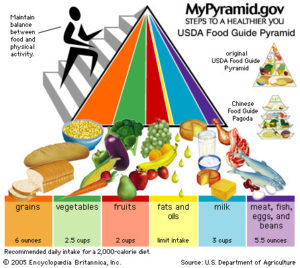It seems that many are constantly seeking changes to his or her diet to obtain that healthy weight loss they desire. However, more often than not, these same people will not stick to any diet long enough to determine how the diet actually affects them. What must accompany your nutritional goal(s) is the evaluation of yourself after you’ve been on a sustained nutritional plan for a number of months.
Just like fitness, nutrition is long term, especially the benefits. Thus, in your pursuit of good nutrition, allow at least three months on any new nutritional plan to determine the value and benefits you derive from it. Why? What typically happens? Lets look at fitness. On a three month fitness plan of 3-5 hours per week of exercise, the general result obtained, assuming an appropriate diet is adhered to as well, is that one will begin to notice leaning in the shoulders and leg areas since burning fat is typically first noticed here.
The longer you stay on the program the better you begin to look. The fact is, your body takes awhile to adjust to a fitness program and then, another period of time to begin showing results. Nutrition follows these same principles. Be patient, develop a plan, and stick to it, i.e., be consistent so that you can verify the affects of the plan.
Some of the primary items you should look for in any diet or nutritional plan in terms of consistency are 1) is there a variety of foodstuffs in the plan; 2) does the plan help you alter eating habits; 3) is the nutritional plan balanced between fats, carbohydrates, and proteins; and 4) how did your body respond to it? Again, the latter is essential in performing any evaluation of ones reaction to a nutritional plan. And, not everyone will react the same to a given plan.
For example, recently we placed 22 females on a very low carb, experimental diet. Within a couple of weeks a majority of the participants were losing weight, which was the expected result for the diet. However, several of the women became very puffy in appearance and actually began gaining weight. As a result, their diet had to be modified. This is an example of quick results; generally, results are slower, which reinforces the admonition of consistency.
General Steps:
- Develop your nutritional plan
- Begin adhering to the plan
- Evaluate the results
- Start the cycle over.
Follow the fours steps above until you find a nutritional plan that works for you. Stick with it for at least three months (this does not mean sticking to a fad diet for three months such as no carbs, or other type diets; it means a good nutritional plan that is not considered a diet). And, make sure that you include foods that you enjoy otherwise, you’ll find it very difficult to follow any nutritional plan.
Try The Following To Begin A Sound Nutritional Program:
Begin with the USDA “Food Guide Pyramid” and Temper It!
Every 5-10 years or so, the United States Department of Agriculture (USDA) and Department of Health and Human Services (DHHS) release dietary guidelines that provide nutritional advice to Americans. These guidelines are meant to serve as the basis for the familiar “Food Guide Pyramid” (see figure below – it is of 1992 vintage) that categorizes foods and suggests the number of servings people should eat from each food group.
The updated food pyramid is below.

The pyramid shape shows the proportions that various food groups should contribute to the total diet. Food groups at the wide base of the pyramid, for example, are to be eaten in greater quantity than food groups that appear toward the narrower top.
Carbohydrates
Over the past two decades, dietary recommendations have emphasized the importance of consuming more carbohydrates–which includes such foods as bread, pasta, potatoes, and rice–in place of dietary fat. The original rationale behind the suggestion is that people who fill up on carbohydrates are less likely to eat fat. Many studies, however, have provided evidence that not all fats are bad and that not all carbohydrates are good. Based on this evidence, Dr. Tindall says the current guidelines promote over-consumption of carbohydrates.
The current food pyramid suggests between 6 and 11 servings of bread, cereal, rice, or pasta every day. Dr. Tindall says that whole-grain sources of carbohydrates are good. But otherwise he believes this food group is overemphasized. Actually, the Food Guide Pyramid consists of a daily intake of about 65% of daily calories from carbohydrates. This would likely be best restricted to no more than 55%, which is the number used for athletes who are very active.
Whole grains still have their outer (bran) layer and inner (germ) layer. During the milling and production of refined grains (like white flour), the healthful bran and germ layers are removed-and with them go many important nutrients, like vitamins, minerals, and fiber. Eating too many refined-grain foods has been linked to diabetes as well as heart disease.
Dietary Fat
Not all fat is bad. Trans fat and saturated fats are unhealthy because they can adversely effect blood cholesterol levels and increase the risk of heart disease. However, unsaturated fats can have the opposite effect-improving blood cholesterol levels and lowering the risk of heart disease in other ways.
The main sources of trans fat are processed and ready-to-eat foods, commercially fried foods, stick margarine, and snack foods. Saturated fats are found mainly in meats, butter, and high-fat dairy products. The main sources of unsaturated fats are vegetable oils, as well as nuts and seeds, which Dr. Tindall would like to see receive greater positive emphasis. Rich in heart-healthy nutrients and unsaturated fats, a number of studies have reported that nuts are linked to a lower risk of developing heart disease.
Fruits, Vegetables, and Dairy Products
The current guidelines recommend three to five servings per day of vegetables, two to four servings per day of fruits, and two to three servings per day from the milk, cheese, and yogurt group. Dr. Tindall believes that Americans should be eating more servings of fruits and vegetables, while eating fewer dairy products. He says that most healthy adults do not need two to three servings of dairy in their daily diets.
However, it is necessary to get adequate calcium to promote normal bone development and maintenance. But most people do not need the amount of calcium provided by two to three daily servings of dairy products. Moreover, there’s some question about the benefits of dairy products as a tool for preventing osteoporosis. In studies of adult women, researchers have found that greater consumption of milk or other food sources of calcium does not substantially protect against hip or forearm fractures.
This, combined with other findings that suggest that high calcium intake may increase the risk for certain cancers, suggests the value of reducing dairy in the diet, seeking calcium from other sources if necessary, and finding other, more effective means of preventing osteoporosis. For more information.
Meat Group
Currently, red meat, poultry, fish, dry beans, eggs, and nuts are grouped together in the USDA’s Food Guide Pyramid. These foods share the property that they are higher sources of protein than the other food groups, providing the body with the amino acid building blocks it requires to make any protein it needs. However, these dietary proteins are not all equally healthy.
For example, many nutritionists would like to see more emphasis on fish (the American Heart Association now recommends two servings of fish per week), with red meat limited in its recommendations for consumption. This is because intake of red meat has been associated with increased risk for colon cancer. Also, within the category of meat, some types are especially bad for health, including processed and preserved meats, such as bacon, sausage, and luncheon (salami-type and cured) meats. These meats are high in salt and preservatives and are generally higher in saturated fat.
There is also considerable evidence that replacing red meat with nuts, legumes, chicken, and fish reduces the risk of developing heart disease. Dried beans, peas, and other legumes are very low in saturated fat, yet they are high in dietary fiber and good sources of protein.
Alcohol
During the last several years, convincing research has shown that moderate alcohol consumption can reduce risk of heart disease and ischemic stroke. In future revisions of the pyramid.
Nutrition scientists at Harvard analyzed the findings from several studies of alcohol intake. The studies, which included research from the United States, Britain, Denmark, and France, investigated the relation between alcohol intake and the development of heart disease. The combined analysis revealed that moderate drinking (about one to two drinks per day for women, and two to three for men) reduces the risk of heart attack in healthy individuals by at least 25 percent. The authors found equal benefit for beer, wine, and spirits.
One negative consequence of moderate alcohol use is an increase in breast cancer risk. (One drink per day is associated with about a 9 percent increase in risk.) However, recent studies suggest that this risk may be avoided with adequate intake of folate. No other adverse health effects of moderate alcohol intake have been established.
On the other hand, the adverse health and societal impact of excessive alcohol consumption is well-documented. Clearly, it’s better not to drink at all than to drink to excess. However, studies consistently show that moderate drinkers have the lowest mortality rates. Since each person is different, the best advice is to discuss these risks and benefits with your physician. Certainly, pregnant women should avoid alcohol altogether, as should people with a history of alcohol abuse.
Temper the Pyramid so that it Reflects:
- Whole grain foods, vegetable oils, and fruits and vegetables are emphasized.
- Physical activity and weight control are emphasized.
- Red meat and refined grains (like white bread and white rice) are de-emphasized and listed as items that should only be eaten sparingly.
- Nuts and legumes receive their own category.
Dairy products are de-emphasized and placed in a category with calcium supplements. - A daily multivitamin tablet is recommended for most people, and moderate daily alcohol intake is a healthy option unless this does not make sense for the individual.
This can be accomplished by following Dr. Tindall’s recommendations from the table below:
| Food Items | Dr. Tindall’s Recommendation | Compare to food guide pyramid above |
|---|---|---|
| Red meat, butter, White bread, white rice, bread and pasta, sweets (candy, soda, etc.) | Use sparingly | 2-3 servings 6-11 servings |
| Dairy or calcium supplement | 1-2 times/day | 2-3 servings |
| Fish, poultry, eggs | 0-3 times per day (1) | 2-3 servings |
| Nuts, legumes | 1-3 times/day | 2-3 servings |
| Fruits | 2-3 times/day | 2-4 servings |
| Vegetables | In abundance | 3-5 servings |
| Whole grain foods | with most meals | |
| Plant Oils: canola, corn, olive, peanut, soy, sunflower, and other vegetable oils | As needed for % dietary fat in combination with food preparation | |
| Alcohol | In moderation (unless you are constrained for such or it does not make sense for you) | |
| Multiple Vitamin Supplement | Daily | |
| FITNESS(Must be combined with nutritional goals). | Exercise daily (45-60 minutes for 6 days or 4-5 hours per week) |
(1) Eggs are often restricted to about 2 eggs per week for those suffering from high cholesterol. If you desire eggs, an egg substitute may be best for you.






